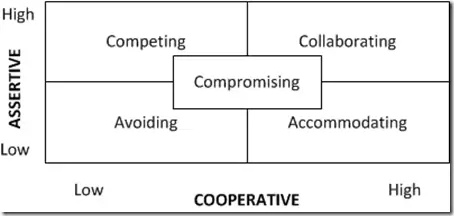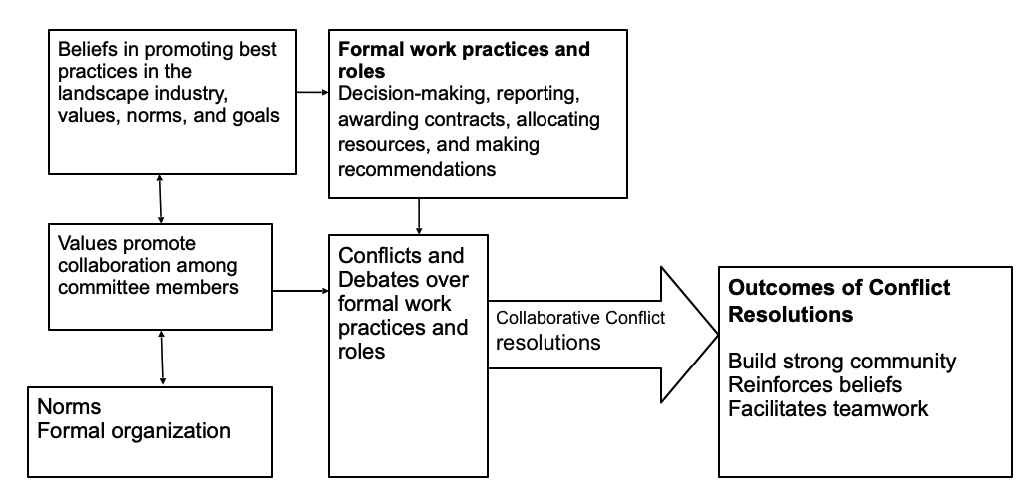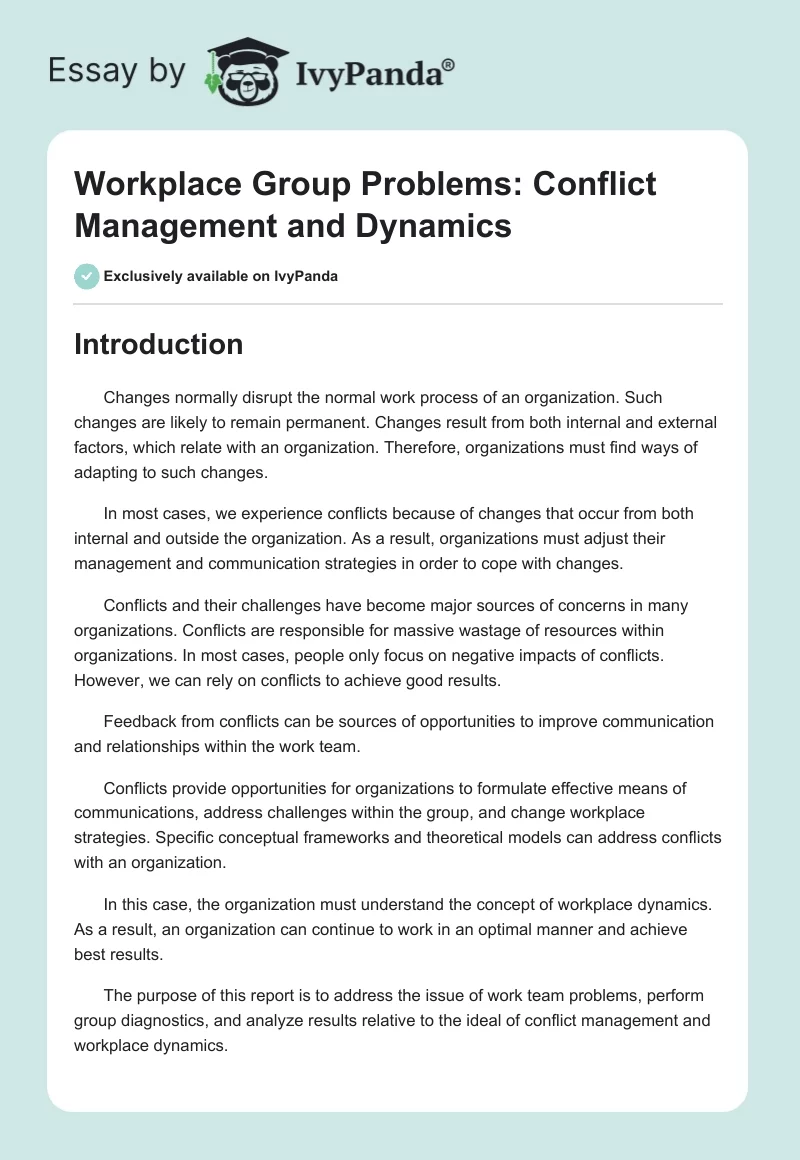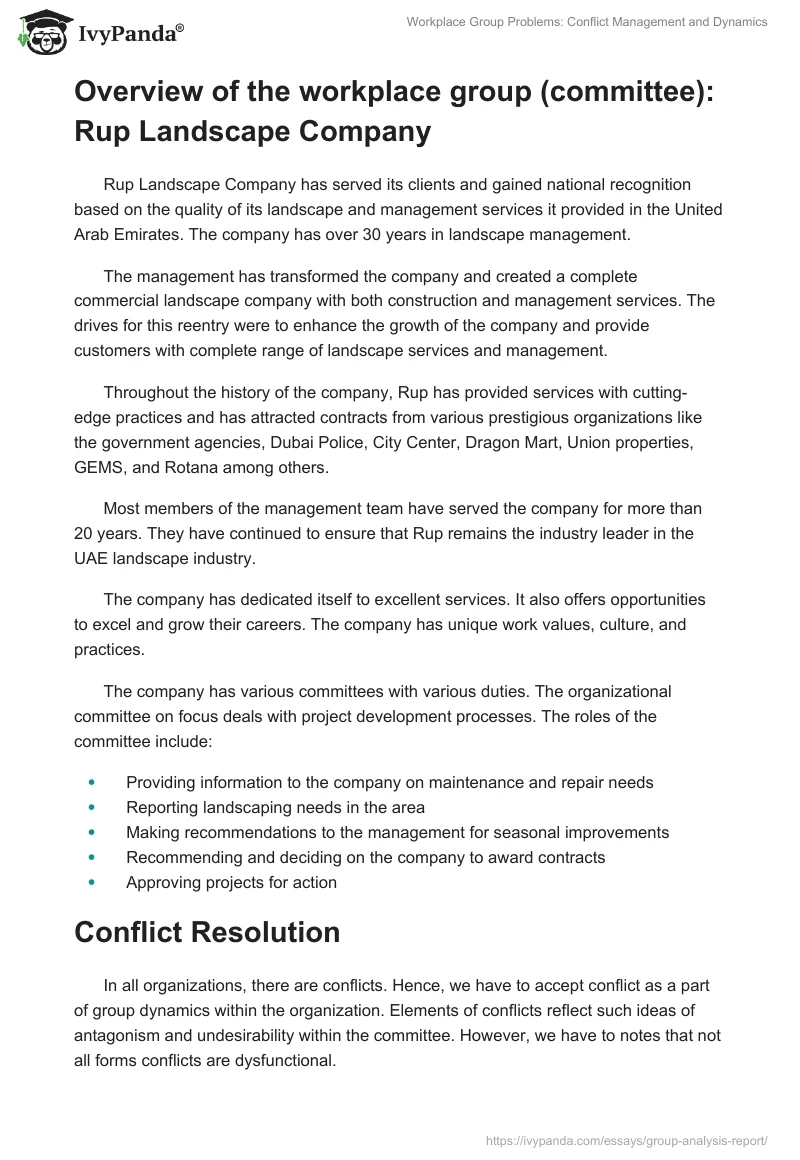Introduction
Changes normally disrupt the normal work process of an organization. Such changes are likely to remain permanent. Changes result from both internal and external factors, which relate with an organization. Therefore, organizations must find ways of adapting to such changes.
In most cases, we experience conflicts because of changes that occur from both internal and outside the organization. As a result, organizations must adjust their management and communication strategies in order to cope with changes.
Conflicts and their challenges have become major sources of concern in many organizations. Conflicts are responsible for massive wastage of resources within organizations. In most cases, people only focus on negative impacts of conflicts. However, we can rely on conflicts to achieve good results.
Feedback from conflicts can be source of opportunities to improve communication and relationships within the work team.
Conflicts provide opportunities for organizations to formulate effective means of communication, address challenges within the group, and change workplace strategies. Specific conceptual frameworks and theoretical models can address conflicts with an organization.
In this case, the organization must understand the concept of workplace dynamics. As a result, an organization can continue to work in an optimal manner and achieve best results.
The purpose of this report is to address the issue of work team problems, perform group diagnostics, and analyze results relative to the ideal of conflict management and workplace dynamics.
Overview of the Workplace Group (Committee): Rup Landscape Company
Rup Landscape Company has served its clients and gained national recognition based on the quality of its landscape and management services it provided in the United Arab Emirates. The company has over 30 years in landscape management.
The management has transformed the company and created a complete commercial landscape company with both construction and management services. The drives for this reentry were to enhance the growth of the company and provide customers with complete range of landscape services and management.
Throughout the history of the company, Rup has provided services with cutting-edge practices and has attracted contracts from various prestigious organizations like the government agencies, Dubai Police, City Center, Dragon Mart, Union Properties, GEMS, and Rotana among others.
Most members of the management team have served the company for more than 20 years. They have continued to ensure that Rup remains the industry leader in the UAE landscape industry.
The company has dedicated itself to excellent services. It also offers opportunities to excel and grow their careers. The company has unique work values, culture, and practices.
The company has various committees with various duties. The organizational committee on focus deals with project development processes. The roles of the committee include:
- Providing information to the company on maintenance and repair needs
- Reporting landscaping needs in the area
- Making recommendations to the management for seasonal improvements
- Recommending and deciding on the company to award contracts
- Approving projects for action
Conflict Resolution
In all organizations, there are conflicts. Hence, we have to accept conflict as a part of group dynamics within the organization. Elements of conflicts reflect such ideas of antagonism and undesirability within the committee. However, we have to note that not all forms conflicts are dysfunctional.
Depending on how a firm handles its conflict, there are productive aspects of conflict that can bring in new solutions to a situation, clarify roles and power relationships within committee members, bring irrational aspects of conflicts into the open, and provide a way of solving conflicts.
If a group engages in destructive conflict, then the outcomes can result in loss of the main objectives in the quest for sub-group interests, encourage the committee members to be defensive, and may results in a collapse of the committee.
According to Condliffe, “Conflict has three vital components, which include interests, emotions, and values. Conflict processes go through stages of perception, realization, avoidance, flashpoint, intervention, strategy, and evaluation” (Condliffe, 2002).
Conflict models allow people to understand what conflicts are, their root causes, and avoidance strategies. However, such models cannot provide all the solutions to conflicts. Rather, they provide us with better ways of understanding conflicts and resolution methods.
We shall use the Thomas-Kilmann Conflict Model (Swinton, 2006) in an attempt to understand the conflict within the committee of Rup Landscape Company.
The committee has been involved in conflict on several occasions. In few cases, the results have been unsatisfactory and cause disharmony, fallout, and distractions from the core duties of the committee. In addition, the organization also experiences losses attributed to productivity (Tillett and French, 2006).

The Thomas-Kilmann Conflict Mode Instrument
Conceptual Frameworks and Group Diagnostics
Rup is a formal organization that promotes landscape services and management in Dubai. The committee shares common goals and values. Consequently, Rup has beliefs, values, and norms for its group members.
Such values, norms, and beliefs rest on the ideology of developing and promoting success of the organization and career growth of members. Therefore, collaboration within the committee is paramount. The belief system consists of a strong belief in the development and use of best practices within the organization.
The organization instills the value of collaboration and community of practice (Hislop, 2005). It has formal work systems, which members interact through open communication systems.
Conflicts usually occur due to differences in decision-making on awarding contracts and allocating scarce resources to projects, values, and goals. Such conflicts have repercussions for the organization.
The organization has used opportunities from conflict resolutions to build a strong community, reinforce its beliefs, values, and norms. In addition, it has strengthened teamwork within the committee.

Conceptual Framework for Rup
Belief in Best Practices, Values, Norms, and Goals
Rup believes in promoting best practices, values, norms, and goals in the landscape industry. The committee members believe in using Rup’s goals and practices for guidance. Therefore, members can collect, organize, recommend, and award tenders to other stakeholders.
The organization aims to promote develop such values, practices, and achieve its goals through its committee. However, the belief in using, developing, and promoting the use of formal practices varies among members.
There are members with strong beliefs in developing and promoting best practices while other have moderate view about formal practices of the organization. This was according to some of the responses from members of the committee.
Members who had a strong belief in promoting best practices, values, and norms in order to achieve organizational goals did not express conflicts.
On the other hand, members who had moderate views about formal practices in the committee had conflicts with other members of the committee. These divergent views led to conflicts among members.
Achieving Goals
The committee members worked together in order to achieve the organizational strategic goals. Goals had two aims, which were to promote the growth of the company and its employees. Such goals enhanced formal approaches to tasks. However, roles and desire to achieve goals differ based on what different members prefer.
The organization had fix deadlines and assigned projects to its members. At the same time, members had the freedom to select the best formal practices of accomplishing tasks.
Most members believed that the committee had to use both formal and informal practices when allocating resources, awarding tenders, and reporting on the progress of various tasks while other members insisted on the use of formal practices in order to enhance the image of the organization.
Collaboration Among Members
In most cases, the committee had to collaborate in most projects. This was the only formal way to grow the organization and achieve both personal and organizational goals. Therefore, the committee had to develop a strong sense of collaboration because of its belief in best practices within the industry.
Conflicts arise when other members of the committee preferred informal aspects of managing certain roles of the committee. Ultimately, the committee worked as a team in order to resolve conflicts in belief systems and strengthen its membership.
Collaboration Creates Value for the Committee
The committee collaborates in order to provide best services to clients and ensure the growth of the organization. Committee aims to create a strong community because of its collaborative approach to issues.
Members can make their contributions and expect positive criticism on the best methods to adopt towards a given projects. The committee hopes that collaborative approach will allow all members to contribute and enhance teamwork.
This is a way of reducing cases of conflicts within the committee. The committee leadership promotes collaborative approach towards issues.
Open Systems
The committee encourages open systems in communications among members. Committee members have the freedom to express their opinions about some decisions about projects. The committee keeps records of important decisions that members make about tasks.
This enables members to track their decisions and improve on areas with faults. The committee encourages its members to refer and report any failures in the decision-making processes that can lead to failure in a project. It encourages open criticism in project management.
Some members believe that the organization can use both formal and informal approaches when making decisions in order to facilitate processes and eliminate bureaucratic tendencies, which cause delays in project completion.
On the other hand, some members promote formal approach for accountability of processes in decision-making.
Formal Management System
The leadership of the committee relies on formal management systems. The committee has developed from a community of practice because of organizational shared goals. There are no formal contracts within the organization. The committee aims to create formal systems in the company.
The committee can only realize this goal through collaboration among members with divergent views. Thus, it can integrate different ideas in order to strengthen formal processes within the organization.
Formal processes aim to instill accountability within the organization. Thus, committee members can feel that they have personal responsibility for organizational goals.
Group Diagnostic
Developing the Committee
Hislop (2005) notes how a community of practice evolves among members, and such shared interests can create a strong committee. Members usually share common goals, values, and similar outcomes. In such communities, members should resolve their differences without any external interference.
The committee has been able to solve its disputes as they arise, and members can trace resolutions in the communication log and archive. The committee may have constant conflicts, but its leadership must resolve such conflicts in collaborative ways in order to strengthen the committee.
Conflict Resolution
The committee uses a collaborative approach to solve all conflicts it experiences. Conflicts emanate from different views on decision-making processes. Collaboration allows members to adopt moderate views in projects for a win-win situation for the organization and its clients.
In the end, the committee aims to achieve formal processes in decision-making.
Conflicts occur because the committee considers formal processes as bureaucratic and time-consuming. Therefore, some members prefer informal processes of decision-making. The resulting conflicts take a great amount of time to solve because the process must account for views all members of the committee.
It is important to note that solutions usually result in a strong committee with a reinforced belief in organizational values and goals.
The committee also displays elements of group dynamics just like in any other group. Committee members have diverse behaviors and attitudes. Concepts of group dynamics relate to both formal and informal organizations (Luthans, 2005).
The group dynamics enable us to understand how the committee co-ordinates its structures, functions, process, and conflict resolution mechanism.
The committee works together with the aim of achieving a common goal of developing and promoting the best practices. However, informal processes interfere with the progress achieved and affect choices of projects and periods of completion.
The formal nature of the process requires members to have specific duties based on their expertise and competence. Some members do not observe formal organizational practices in decision-making and distribution of resources, which result in conflicts within the committee.
However, the committee resolves such conflicts through a collaborative process in which all committee members express their views. The aim of conflict resolution is to strengthen teamwork and belief in organizational best practices and formal approach to processes.
Developing Teamwork
Effective conflict resolution within the committee encourages teamwork. Members look for various solutions to their problems by expressing their ideas in an open system. Opinions on whether the committee should still depend on its old informal practices or implement changes that focus on formal processes differ.
Collaboration has formed the basis of resolving such conflicts within the organization. The committee promotes teamwork by inviting contributions from all members in problem-solving.
Changes for Improvement
Landscape services and management industry has become competitive in UAE. Many companies have emerged to compete for the same clients. Therefore, only organizations with best practices shall succeed. This is the aim of Rup.
A collaborative approach in conflict resolution has created a strong team that aims to promote best practices within the organization. In addition, it has reinforced the belief in organizational values and goals. Conflicts will emerge as Rup finds the best ways of providing services through effective decision-making processes.
However, some conflicts take a lot of time to resolve. Therefore, the committee should improve on time management when resolving conflicts. It should adopt gradual change processes to ensure that members adopt formal practices within the organization.
Members’ satisfaction varies based on the adoption of formal practices within the committee. Some members promote the use of both formal and informal processes in decision-making, reporting, and awarding tenders. On the other hand, some members advocate for formal processes.
However, the committee aims to solve such problems by adopting a collaborative model. This has ensured that the committee considers contributions from all members and makes decisions on the best interests of all stakeholders.
The committee must understand its own weaknesses in order to improve on adopting changes and decision-making process. The committee leadership should rely on scenario-based models in order to choose appropriate conflict resolution model that can serve the organization under time pressure.
The committee should not overuse the collaborative model to the extent that leads to compromise of goals, values, and long-term goals of Rup.
Conclusion
Changes in the modern industries are responsible for many conflicts. Therefore, conflicts are inevitable in such organizations. Rup shows that conflict can be favorable for creating effective outcomes, teamwork, and a strong community.
The organization has been able to achieve such results because of a collaborative approach to conflict resolution.
However, the committee must improve on change and time management because members are reluctant to adopt best practices and values. As a result, conflict resolution is time-consuming processes that delay other projects.
References
Condliffe, P. (2002). Conflict management: a practical guide. Sydney: Nexis Butterworths.
Hislop, D. (2005). knowledge management in organizations: A critical introduction. Oxford: Oxford University Press Inc.
Luthans, F. (2005). Organizational Behavior (10th ed.). Boston: McGraw-Hill.
Swinton, L. (2006). Workplace Conflict Management: Strategy for Successful Resolution. Web.
Tillett, G., and French, B. (2006). Resolving conflict: a practical approach, 3rd edition. Melbourne: Oxford University Press.


